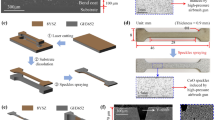Abstract
In the present paper the time and temperature dependent evolution of the microstructure of TBC systems and especially of post-experimentally determined physical defects in and around the TGO for both isothermal and cyclic exposure conditions are investigated. Specimens with APS- as well as with PVD-topcoats have been oxidised between 950 and 1100°C up to a maximum duration of 5000 h followed by extensive scanning electron microscopy and subsequent interactive image analysis to measure the maximum crack lengths in and around the TGO. These cracks are additionally classified with respect to their local orientation in the TGO or its vicinity. The results of isothermal and cyclic test conditions show a number of similarities in results e.g. an unsystematic occurrence of inwardly growing, “cauliflower like” oxide or the most frequently occurring type of cracks in APS systems. Nevertheless substantial differences concerning the final failure, microstructure, crack growth behaviour and finally life time of the component between isothermal and cyclic test conditions exist. Some indications were found, that for this particular bond coat occurance of inwardly growing oxide intrusions increases the adherence of the TGO.
Similar content being viewed by others
References
W. J. QUDAKKERS, A. K. TYAGI, D. CLEMENS, R. ANTON and L. SINGHEISER, in “Proc. Elevated Temperature Coatings: Science and Technology III,” edited by J. Hampikian and N. B. Dahotre (TMS, Warrendale, 1999) p. 119.
R. ANTON, S. K. JHA, D. CLEMENS, W. MALLENER, L. SINGHEISER and W. J. QUADAKKERS, in “EFC Publications No. 27: Cyclic Oxidation of High Temperature Materials,” edited by M. Schütze and W. J. Quadakkers, (IoM Communications, London, 1999) p. 339.
J. T. DEMASI, K. D. SHEFFLER and M. ORTIZ, “Thermal Barrier Coating Life Prediction Model,” NASA-Report, CR 182230 (1989).
S. M. MEIER, D. M. NISSLEY and K. D. SHEFFLER, “Thermal Barrier Coating Life Prediction Model,” NASA-Report, CR 189111 (1991).
H. ECHSLER, D. RENUSCH and M. SCHÜTZE, in “Proc. Turbomat Symposium,” published by DLR, German Aerospace Center, Institute of Materials Research (Köln, Germany, 2002) p. 152.
M. SCHÜTZE, in Protective Oxide Scales and their Breakdown, (John Wiley & Sons, Chichester, 1997).
E. BERGHOF-HASSELBÄCHER, H. ECHSLER, P. GAWENDA, M. SCHORR and M. SCHÜTZE, Prakt. Metallogr. 33 (2001) 275.
H. ECHSLER, D. RENUSCH and M. SCHÜTZE, Mater. Sci. Tech. 20 (2004) 307.
H. ECHSLER, in “Oxidationsverhalten und mechanische Eigenschaften von Wärmedämmschichten und deren Einfluss auf eine Lebensdauervorhersage,” Ph.D. Thesis, RWTH Aachen, ISBN 3-8322-1895-5 (Shaker, Germany, 2003).
J. XU, Rolls-Royce Deutschland Ltd & Co KG (Dahlewitz, Germany, 2002), private communication.
B. HEINECKE, in “Schädigung von Wärmedämmschichtsystemen mit unterschiedlichen Haftvermittlerschichten unter zyklischer Beanspruchung,” Ph.D. Thesis, TU Darmstadt, ISBN 3-8322-3450-0 (Shaker, Germany, 2004).
Author information
Authors and Affiliations
Corresponding author
Rights and permissions
About this article
Cite this article
Echsler, H., Shemet, V., Schütze, M. et al. Cracking in and around the thermally grown oxide in thermal barrier coatings: A comparison of isothermal and cyclic oxidation. J Mater Sci 41, 1047–1058 (2006). https://doi.org/10.1007/s10853-005-3639-3
Received:
Accepted:
Published:
Issue Date:
DOI: https://doi.org/10.1007/s10853-005-3639-3




